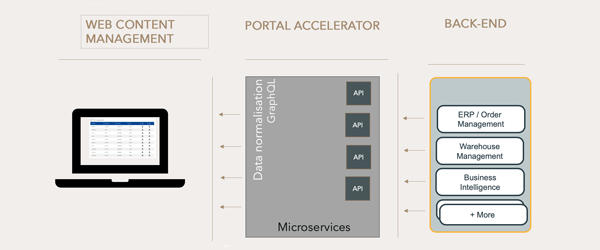B2B Commerce is gradually moving toward 24/7 service
B2B business logic is complex. This means that beginning a customer portal or ecommerce project requires making a gradual move toward 24/7 customer service. Think of your ecommerce or portal development as a journey of creating industry-leading experiences.
An easy way to begin a portal project is to share information that creates value for customers, such as order documentation, order history and status. Once your organisational capabilities have grown to handle digital services, the second step is to move toward transactional commerce. The third and fourth steps in commerce and portal maturity are predictive analytics and the creation of new business models. If you have selected headless and microservices-based IT architecture, it provides the means to expand commerce functionalities over time, as the organisation matures.
Step 1: Show information
Step 2: Transactional commerce
Step 3: Predictive analytics
Step 4: New business models
B2B Businesses have multiple target groups and business needs
Even within a single enterprise, global companies have multiple target audiences and business needs in various divisions. Therefore, it is rare that a single storefront and user interface can match every audience. It is possible for different divisions to need different functionalities, utilise different channels and build their own experiences, in line with the expectations of their target groups. The headless approach makes it easy to create unique experiences, based on the needs of a particular country or segment.
Outdated legacy systems add complexity to commerce projects:
Manufacturing and heavy industry are full of outdated IT systems. This makes it challenging to retrieve information in real time—and frequently, to retrieve information at all! The ability to integrate and upgrade one part of a solution, without affecting the rest of the solution, is important. For example, you might want to work on a pricing module, independent of order-tracking. Decoupling solutions generally requires microservice, or an API-based, headless-solution approach.
Another approach is monolithic, a more traditional way to look at ecommerce. For many B2B companies, monolithic, all-in-one platforms offer a good way to begin in ecommerce. When standard products or spare parts are sold and integrations are not complex, standardized monolithic architecture is a quick and easy way to implement portals and commerce solutions. Monolithic platforms offer all functionality from a single platform. This way, organisations don’t need to acquire or manage multiple applications separately. Headless architecture tries to find optimised applications and solutions for specific purposes.






